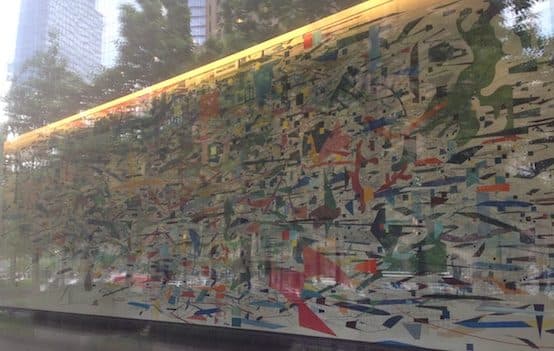
Critics of Goldman Sachs love to say the investment bank highlights the failures of everything from capitalism and neoliberalism to democracy and socialism. Millions of words have been written depicting Goldman as the central villain of the Great Recession, yet little has been said about their most egregious sin: their lobby art. In 2010, Goldman Sachs paid $5 million for a custom-made Julie Meheretu mural for their New York headquarters. Expectations are low for corporate lobby art, yet Meheretu’s giant painting is remarkably ugly—so ugly that it helps us sift through a decade of Goldman criticisms and get to the heart of what is wrong with the elites of our country.
Julie Mehretu’s “The Mural” is an abstract series of layered collages the size of a tennis court. Some layers are colorful swirls, others are quick black dash marks. At first glance one is struck by the chaos of the various shapes and colors. No pattern or structure reveals itself. Yet a longer look reveals a sublayer depicting architectural drawings of famous financial facades, including the New York Stock Exchange, The New Orleans Cotton Exchange, and even a market gate from the ancient Greek city of Miletus.
What are we to make of this? Meheretu herself confirms our suspicion that there is no overarching structure to the piece. “From the way the whole painting was structured from the beginning there was no part that was completely determined ever. It was always like the beginning lines and the next shapes. So it was always this additive process,” she said in an Art 21 episode.
Does all art need a strict and coherent structure? Of course not. Yet consider Mehretu’s mural in juxtaposition with Jackson Pollock’s drip paintings. Both are large, abstract, and improvisational. Pollock painted by moving the canvas to the floor and dripping paint down, making the act of painting more akin to dance. Meheretu made her piece on a computer and then had a team of assistants actually paint it on the wall. Pollock’s jazz-inspired swirls and textures evoke raw emotion unfiltered. They invite us to look at the painting as a painting, and not for some further content. If there are any defenders of the Goldman mural, they’re probably hiding behind similar arguments and offering platitudes appealing to the idea of expression for the sake of expression: that the painting justifies itself simply by existing. However, Meheretu does not allow for this easy out. Unlike Pollock, she includes something more than paint: the facades of famous financial buildings, by which she implies artistic argument, content outside of form.
So what is the painting trying to say? Nothing.
The glimmers of old-world beauty demand to be accounted for, and yet because there is no coherent structure to the piece, we can find no true justification for their inclusion, other than that they reference who paid for the painting. Again, Mehretu’s own words confirm what is immediately visible: “I think there’s a lot of meaning in the painting, but I would never want to articulate a direct statement. I think maybe that’s a big reason I work with abstractions so that you can’t necessarily pinpoint a specific narrative.”
Good art doesn’t need an easily packaged message, theme, or subject, and it could be argued that the greatest works of art have a way of championing the hard-to-articulate experience, which Wittgenstein would have us leave in silence. This is not what’s going on at Goldman Sachs, however. The inclusion of the famous facades in a painting created specifically for one of the most powerful investment banks on earth is meant to be evocative, but because there is no narrative, there is no way to produce coherence. Obviously it is a nod to global finance, and yet Mehretu provides no larger framework by which we can judge this against itself. Would the piece be materially different if you swapped the financial buildings for church facades? Is the artist successful on her own terms, let alone ours? We can’t say. We are simply expected to accept that the artist’s choices justify themselves because they were made. This nihilistic approach to meaning in art reflects both our larger cultural moment and how meaning and ethics are approached on the upper floors of Goldman Sachs’ headquarters.
Scottish philosopher Alasdair MacIntyre gave a lecture to Notre Dame’s Center of Ethics and Culture in 2000 about the compartmentalization of our ethical lives. He argued that in modern Western culture these different areas are governed by different ethical norms and standards. The example he gives is how a waiter at a restaurant acts differently in the kitchen than in front of the customer. In the kitchen it is normal to yell, curse, and touch the food with his bare hands; none of this would be appropriate in front of the customer. And when the waiter goes home, his personal life is dictated by a further third set of norms. Or consider how the ethics of lying are treated differently during a job interview versus at home or at a law office. Like the painting in the Goldman Sachs lobby, our ethical lives seem to be made of different layers that don’t connect. Our culture no longer shares a single ethical narrative, and so our choices are not weighed against a standard that’s consistent. Rather, people ask that their choices be accepted simply because they were made. When the bankers over-leveraged prior to 2008, they made a series of compartmentalized choices without considering the larger societal implications. They and the art in their lobby are the same.
I do not think the bankers at Goldman spend each morning scrutinizing their lobbies for larger ethical implications. Nihilistic art does not create nihilistic bankers. Yet both the elites of art and the elites of finance come out of the same culture. Both are indicative of where we are as a society. The Occupy Wall Street crowd may call Goldman a vampire squid wrapped around the face of humanity, but they never apply the same harsh rhetoric to our cultural institutions. A decade after the recession, our contemporary high art is more nihilistic than ever. This informs all areas of our culture. When powerful institutions are discussed we often critique in terms of isms: capitalism, liberalism, managerialism. We forget to mention that our institutions are made up of individuals who share the same culture that we all do. IRS auditors listen to Katy Perry. Federal judges watch comic book movies. The spies at the CIA read Zadie Smith novels. Our morality is informed in part by the art, both high and popular, that surrounds us.
After a decade of ignominy, Goldman Sachs is currently pushing further into consumer finance, which means further onto Main Street. The mural in their headquarters is indicative of the candy-coated nihilism that is also pushing further into our lives.
James McElroy is a young New York City-based novelist and essayist, who also works in finance.
Sourse: theamericanconservative.com






